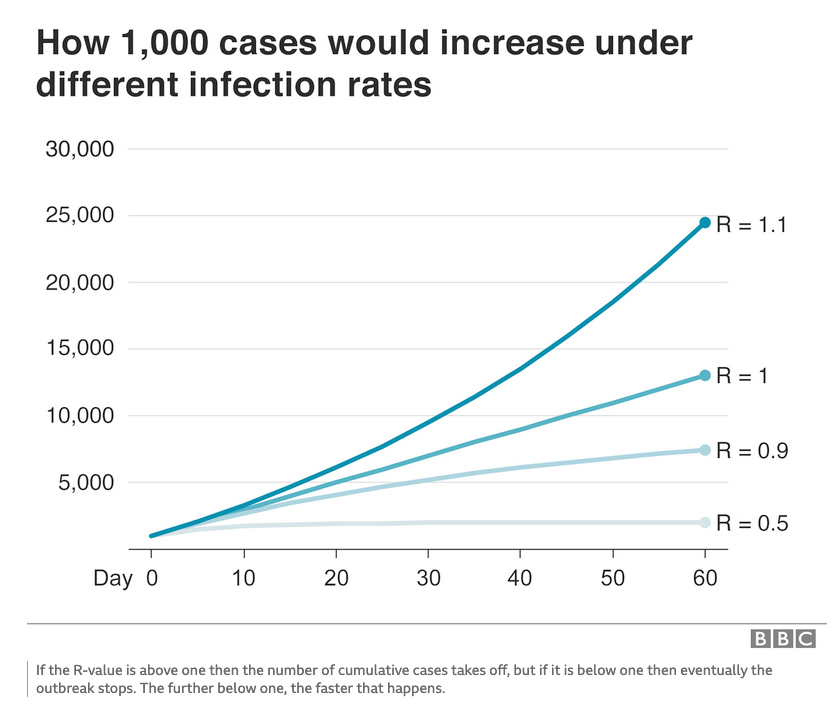A: Remember “flatten the curve”? We still need to “flatten the waves.”
Much has changed since this rallying cry of Spring 2020, but keeping the infamous reproductive rate (or “R-value”) down is still a worthy goal. While we *totally* feel everyone’s pandemic fatigue and frustration with fellow humans, it’s not all or nothing with prevention measures.
We’ve now seen that SARS-CoV-2 comes at us in waves, often sparked by new variants that develop tricks to get around our existing immunity. But how high these waves rise (and thus how many total infections) is not pre-determined by the virus– a lot depends on US.
There are two key factors that impact transmission and whether new waves become tsunamis or gentle ripples.
![]() Population immunity, from both vaccination + infection. By now, most of our immune systems have seen at least one version of this
Population immunity, from both vaccination + infection. By now, most of our immune systems have seen at least one version of this ![]() spike protein. High levels of immunity dampen down (but don’t eliminate) the chances of a new infection, slowing transmission. Waning immunity and immune-evading variants can erode this immunity wall somewhat, setting off new waves. But boosters, improved vaccine technology and better matches to variants can counter this erosion. While population immunity waxes and wanes, we are unlikely to get a variant that sets us back to immunity ground zero.
spike protein. High levels of immunity dampen down (but don’t eliminate) the chances of a new infection, slowing transmission. Waning immunity and immune-evading variants can erode this immunity wall somewhat, setting off new waves. But boosters, improved vaccine technology and better matches to variants can counter this erosion. While population immunity waxes and wanes, we are unlikely to get a variant that sets us back to immunity ground zero.
![]() Our trusty prevention measures, such as: isolating when ill, physical distancing, improving ventilation & wearing masks. It’s STILL true that transmission happens by sharing air with an infected person. Any steps that interrupt this process will reduce transmission.
Our trusty prevention measures, such as: isolating when ill, physical distancing, improving ventilation & wearing masks. It’s STILL true that transmission happens by sharing air with an infected person. Any steps that interrupt this process will reduce transmission.
Even though the intrinsic transmissibility of SARS-CoV-2 has gone up with each new variant, high levels of population immunity mean that the “effective” R-value (how many people on average an infected person will infect) is much lower than it otherwise would be. When the R-value is close to 1, little nudges in either direction can make a BIG difference to whether infections decrease over time, simmer along at a steady rate, or take-off again with exponential growth (see figure).

YOUR efforts at basic prevention, no matter how small they seem, can help break a transmission chain and nudge that R value down below the tipping point.
Keeping overall transmission lower by “flattening the waves” will lead to many fewer infections (and re-infections) over time compared to no prevention at all. And fewer infections mean fewer chances for a SARS-CoV-2 infection to turn serious or into Long COVID. It also buys continued time for even better vaccines and therapeutics.
Those early days of ‘flatten the curve” seem quaint now, with little chance that we will fully eradicate SARS-CoV-2. We’re now playing the LONG game of chess with SARS-CoV-2, but a little prevention still goes a long way.
So, if you are asking yourself, “I’m not that sick, what’s the point of testing or staying home if I’m positive?” or “Why should I bother to keep opening windows or wearing a mask in crowded indoor places?”
Remember it’s the LONG game. Our “tiny wise decisions” can add up to real collective good. Like washing our hands, some prevention measures might need to become second nature (and that doesn’t mean we are living less than our best lives).
Love,
Those Nerdy Girls
_____________
Additional Links:


